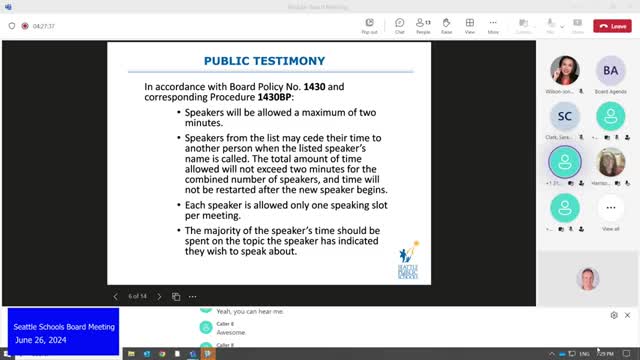Community demands transparency on school budget cuts
June 27, 2024 | Seattle School District No. 1, School Districts, Washington

This article was created by AI summarizing key points discussed. AI makes mistakes, so for full details and context, please refer to the video of the full meeting. Please report any errors so we can fix them. Report an error »

During a recent government meeting, significant concerns were raised regarding proposed budget cuts that could lead to the closure of schools. One speaker emphasized the need for transparency in the financial implications of such decisions, questioning the logic behind closing schools as a primary method to address a projected $100 million shortfall.
The speaker pointed out that while it may seem cost-effective to reduce the number of schools, the actual costs associated with maintaining school buildings are not as high as suggested. They called for a detailed breakdown of maintenance costs and potential savings, arguing that funds currently allocated to expanding school capacity in areas where it is not needed could be better utilized for maintenance and other pressing needs.
Furthermore, the speaker highlighted that the number of teachers required is dictated by student-teacher ratios, meaning that closing schools would not necessarily lead to a reduction in teaching staff or significant savings. Any potential savings from closing schools could be offset by increased transportation costs for students who would need to travel further to attend school.
The speaker urged the school board to demand clear data from the school district on how these proposed actions would benefit the community and improve student outcomes, while also quantifying the actual budget impact. They concluded by advocating for smaller schools, which they believe provide a better learning environment for children.
The meeting underscored the complexities of budget management in education and the need for careful consideration of the long-term impacts of school closures on students and communities.
The speaker pointed out that while it may seem cost-effective to reduce the number of schools, the actual costs associated with maintaining school buildings are not as high as suggested. They called for a detailed breakdown of maintenance costs and potential savings, arguing that funds currently allocated to expanding school capacity in areas where it is not needed could be better utilized for maintenance and other pressing needs.
Furthermore, the speaker highlighted that the number of teachers required is dictated by student-teacher ratios, meaning that closing schools would not necessarily lead to a reduction in teaching staff or significant savings. Any potential savings from closing schools could be offset by increased transportation costs for students who would need to travel further to attend school.
The speaker urged the school board to demand clear data from the school district on how these proposed actions would benefit the community and improve student outcomes, while also quantifying the actual budget impact. They concluded by advocating for smaller schools, which they believe provide a better learning environment for children.
The meeting underscored the complexities of budget management in education and the need for careful consideration of the long-term impacts of school closures on students and communities.
View full meeting
This article is based on a recent meeting—watch the full video and explore the complete transcript for deeper insights into the discussion.
View full meeting
